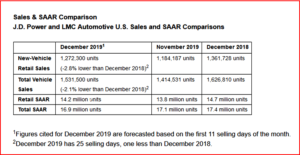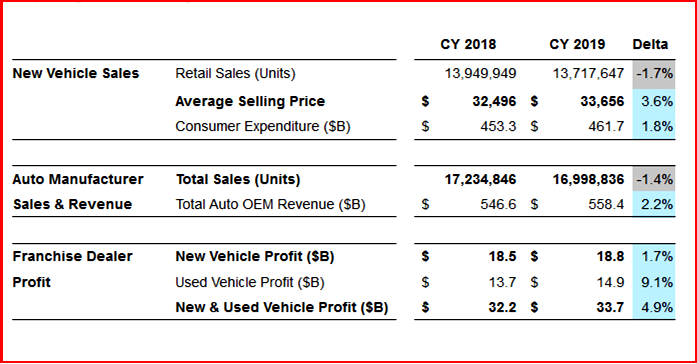
Click to Enlarge.
New-vehicle retail sales in December are expected to be down from a year ago, according to a forecast by J.D. Power and LMC Automotive. Retail sales are projected to reach 1,272,300 units, a -2.8% decrease on a ‘selling day adjusted’ basis compared with December 2018.
Worse, reporting the same numbers without controlling for the number of selling days translates to a decrease of -6.6% vs. last year since December 2019 contains one less weekend and one less selling day than December 2018. New vehicle retail sales for the 2019 calendar year are projected to reach 13,717,600, a -1.7% decrease compared to 2018.
Total Sales Forecast
Total sales in December are projected to reach 1,531,500 units, a -2.1% decrease on a selling day adjusted basis compared with December 2018. Reporting the same numbers without controlling for the number of selling days translates to a decrease of -5.9% over last year.
The seasonally adjusted annualized rate, aka SAAR, for total sales is expected to be 16.9 million units, down -500,000 units from a year ago. New vehicle total sales for the 2019 calendar year are projected to reach 16,998,800, a -1.4% decrease from 2018.
 Executive Opinion
Executive Opinion
“December’s soft performance closes the year on a down note, but another record for transaction prices reinforces that manufacturers are producing the type of vehicles that consumers want in the market,” claimed Thomas King, President of the Data & Analytics Division at J.D. Power. “Record prices, however, have also been accompanied by record incentive levels, which signifies that there is still too much supply relative to overall demand.”
Average transaction prices in December are heading toward a record of $34,602, up $673 from last year. Growth is being driven by prices of truck/SUVs, which are expected to reach $36,935, an increase of $655 from last year. Prices for cars are up to $27,461, a modest increase of $79.
Concurrently, average incentive spending per unit is on pace to reach a record $4,600, an increase of 6.9% (+$296) from a year ago. The previous high for the industry was set last month at $4,520. Overall spending as a percentage of MSRP also remains close to 11%, the highest level since the recession in 2008. Among the 25 top-selling brands in the industry, all but four are expected to show an increase in overall spending.
“Looking at the entire year, annual retail sales will reach more than 13.7 million units in 2019. This represents the 10th-best retail sales year in history and a modest 232,000-unit decline from last year,” King said. “With transaction prices continuing to show robust growth, consumers will spend a record amount of money on new vehicles in 2019.”
The combination of record prices with overall sales means that consumers will spend $462 billion on new vehicles in 2019. This is up $8.4 billion from last year and marks the first time that expenditures will exceed $460 billion.
Looking ahead to 2020, more than 60 new or refreshed models are expected to be introduced, which Power claims should help mitigate further degradation in overall sales. This could also result in smaller slices of the same size pie for models.

About Ken Zino
Ken Zino, editor and publisher of AutoInformed, is a versatile auto industry participant with global experience spanning decades in print and broadcast journalism, as well as social media. He has automobile testing, marketing, public relations and communications experience. He is past president of The International Motor Press Assn, the Detroit Press Club, founding member and first President of the Automotive Press Assn. He is a member of APA, IMPA and the Midwest Automotive Press Assn.
He also brings an historical perspective while citing their contemporary relevance of the work of legendary auto writers such as Ken Purdy, Jim Dunne or Jerry Flint, or writers such as Red Smith, Mark Twain, Thomas Jefferson – all to bring perspective to a chaotic automotive universe.
Above all, decades after he first drove a car, Zino still revels in the sound of the exhaust as the throttle is blipped during a downshift and the driver’s rush that occurs when the entry, apex and exit points of a turn are smoothly and swiftly crossed. It’s the beginning of a perfect lap.
AutoInformed has an editorial philosophy that loves transportation machines of all kinds while promoting critical thinking about the future use of cars and trucks.
Zino builds AutoInformed from his background in automotive journalism starting at Hearst Publishing in New York City on Motor and MotorTech Magazines and car testing where he reviewed hundreds of vehicles in his decade-long stint as the Detroit Bureau Chief of Road & Track magazine. Zino has also worked in Europe, and Asia – now the largest automotive market in the world with China at its center.


Auto Industry Sets Record for Transaction Prices, Incentive Spending in December 2019. However, US Sales Falling?
Click to Enlarge.
New-vehicle retail sales in December are expected to be down from a year ago, according to a forecast by J.D. Power and LMC Automotive. Retail sales are projected to reach 1,272,300 units, a -2.8% decrease on a ‘selling day adjusted’ basis compared with December 2018.
Worse, reporting the same numbers without controlling for the number of selling days translates to a decrease of -6.6% vs. last year since December 2019 contains one less weekend and one less selling day than December 2018. New vehicle retail sales for the 2019 calendar year are projected to reach 13,717,600, a -1.7% decrease compared to 2018.
Total Sales Forecast
Total sales in December are projected to reach 1,531,500 units, a -2.1% decrease on a selling day adjusted basis compared with December 2018. Reporting the same numbers without controlling for the number of selling days translates to a decrease of -5.9% over last year.
The seasonally adjusted annualized rate, aka SAAR, for total sales is expected to be 16.9 million units, down -500,000 units from a year ago. New vehicle total sales for the 2019 calendar year are projected to reach 16,998,800, a -1.4% decrease from 2018.
“December’s soft performance closes the year on a down note, but another record for transaction prices reinforces that manufacturers are producing the type of vehicles that consumers want in the market,” claimed Thomas King, President of the Data & Analytics Division at J.D. Power. “Record prices, however, have also been accompanied by record incentive levels, which signifies that there is still too much supply relative to overall demand.”
Average transaction prices in December are heading toward a record of $34,602, up $673 from last year. Growth is being driven by prices of truck/SUVs, which are expected to reach $36,935, an increase of $655 from last year. Prices for cars are up to $27,461, a modest increase of $79.
Concurrently, average incentive spending per unit is on pace to reach a record $4,600, an increase of 6.9% (+$296) from a year ago. The previous high for the industry was set last month at $4,520. Overall spending as a percentage of MSRP also remains close to 11%, the highest level since the recession in 2008. Among the 25 top-selling brands in the industry, all but four are expected to show an increase in overall spending.
“Looking at the entire year, annual retail sales will reach more than 13.7 million units in 2019. This represents the 10th-best retail sales year in history and a modest 232,000-unit decline from last year,” King said. “With transaction prices continuing to show robust growth, consumers will spend a record amount of money on new vehicles in 2019.”
The combination of record prices with overall sales means that consumers will spend $462 billion on new vehicles in 2019. This is up $8.4 billion from last year and marks the first time that expenditures will exceed $460 billion.
Looking ahead to 2020, more than 60 new or refreshed models are expected to be introduced, which Power claims should help mitigate further degradation in overall sales. This could also result in smaller slices of the same size pie for models.
About Ken Zino
Ken Zino, editor and publisher of AutoInformed, is a versatile auto industry participant with global experience spanning decades in print and broadcast journalism, as well as social media. He has automobile testing, marketing, public relations and communications experience. He is past president of The International Motor Press Assn, the Detroit Press Club, founding member and first President of the Automotive Press Assn. He is a member of APA, IMPA and the Midwest Automotive Press Assn. He also brings an historical perspective while citing their contemporary relevance of the work of legendary auto writers such as Ken Purdy, Jim Dunne or Jerry Flint, or writers such as Red Smith, Mark Twain, Thomas Jefferson – all to bring perspective to a chaotic automotive universe. Above all, decades after he first drove a car, Zino still revels in the sound of the exhaust as the throttle is blipped during a downshift and the driver’s rush that occurs when the entry, apex and exit points of a turn are smoothly and swiftly crossed. It’s the beginning of a perfect lap. AutoInformed has an editorial philosophy that loves transportation machines of all kinds while promoting critical thinking about the future use of cars and trucks. Zino builds AutoInformed from his background in automotive journalism starting at Hearst Publishing in New York City on Motor and MotorTech Magazines and car testing where he reviewed hundreds of vehicles in his decade-long stint as the Detroit Bureau Chief of Road & Track magazine. Zino has also worked in Europe, and Asia – now the largest automotive market in the world with China at its center.